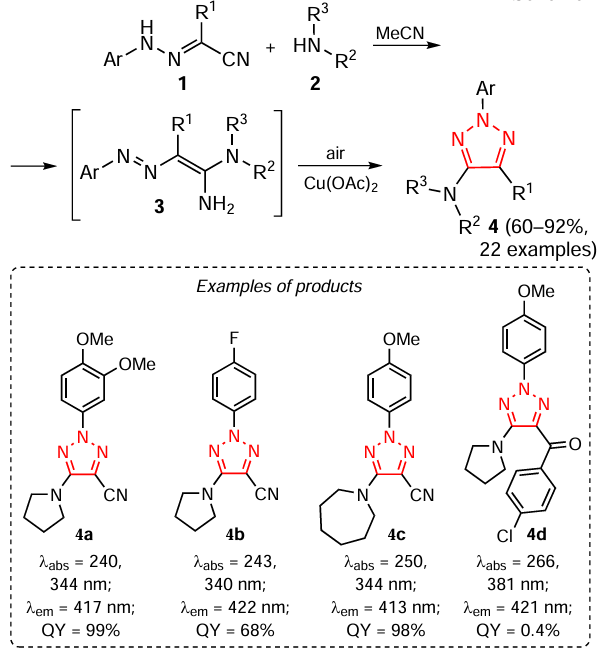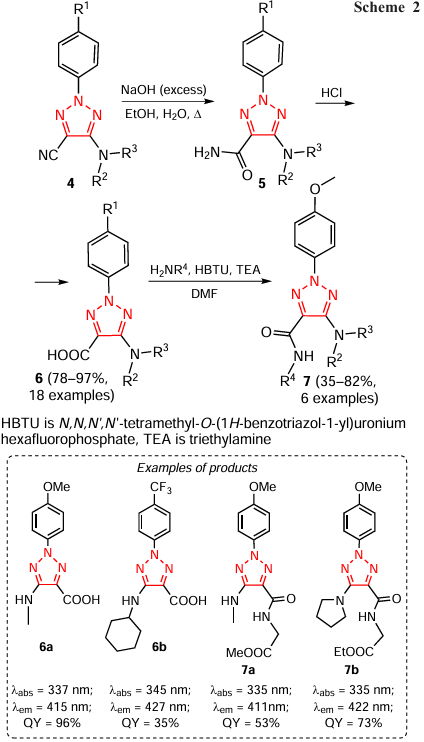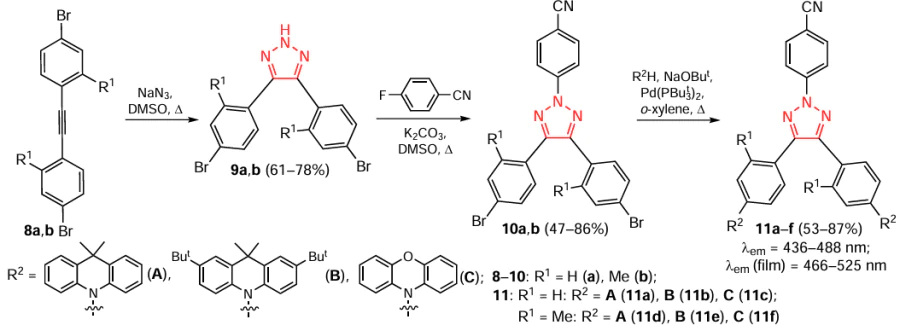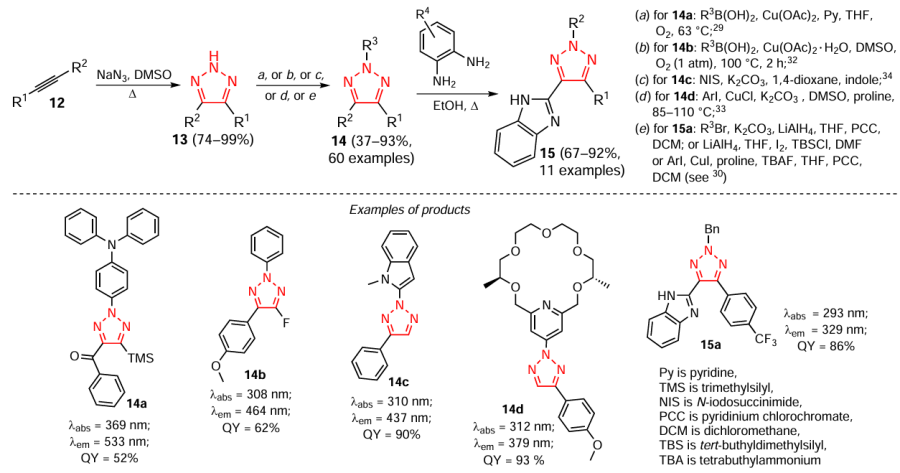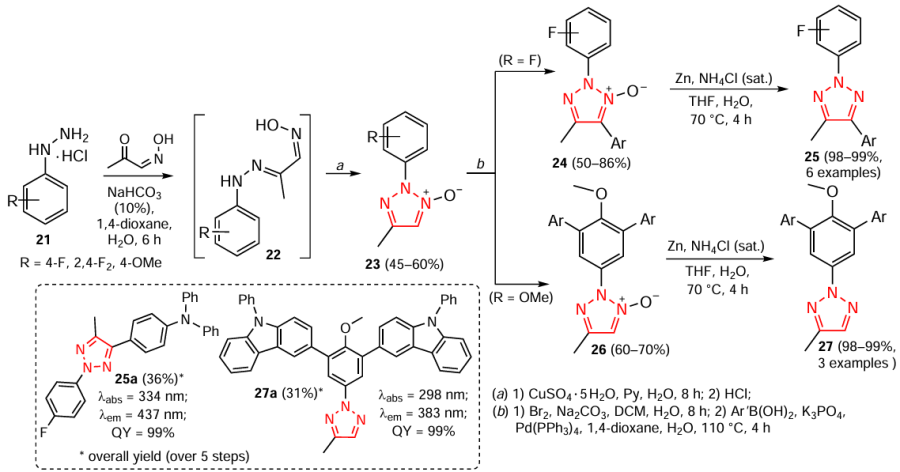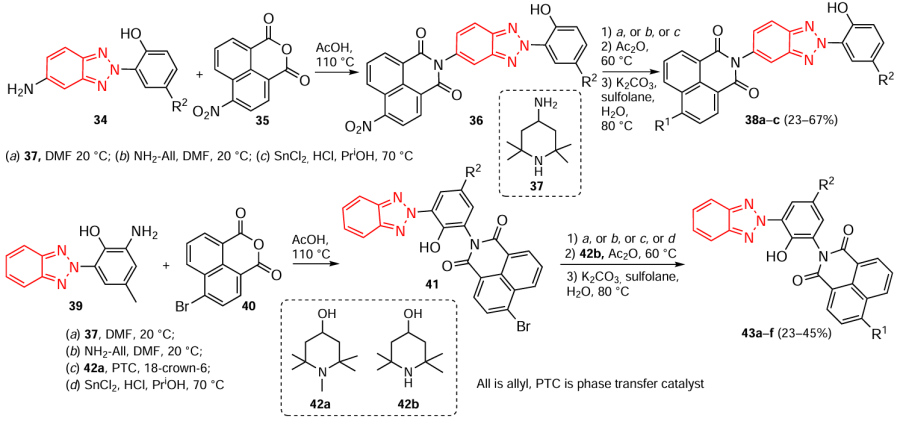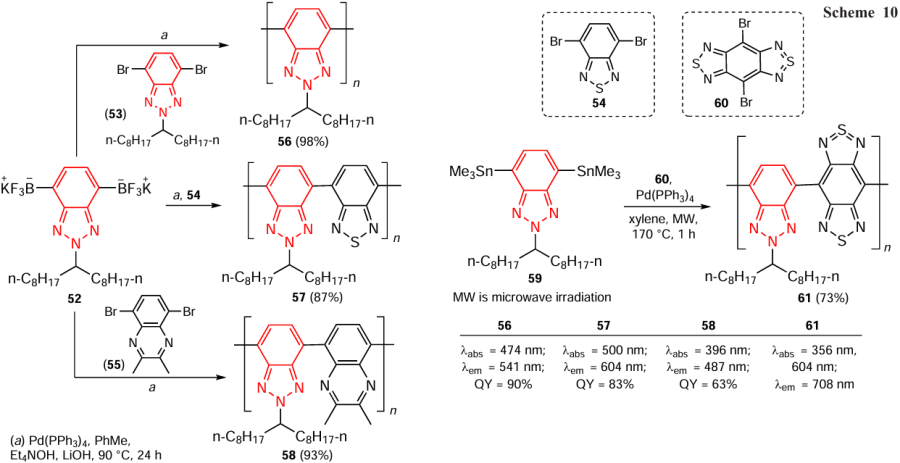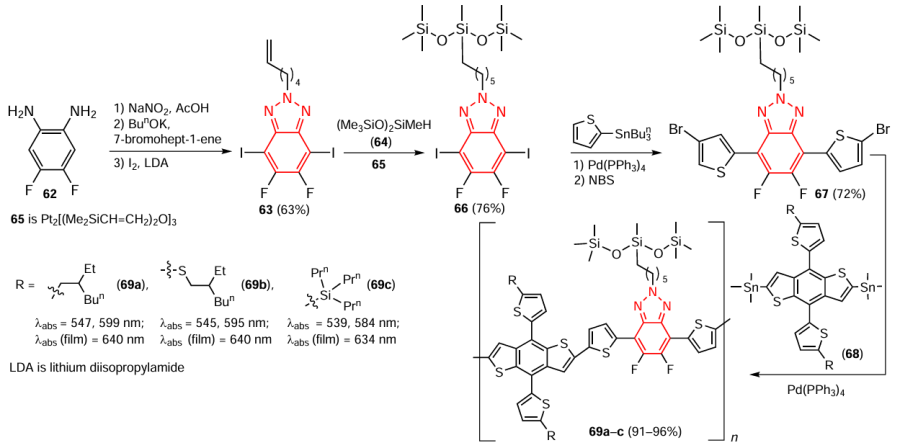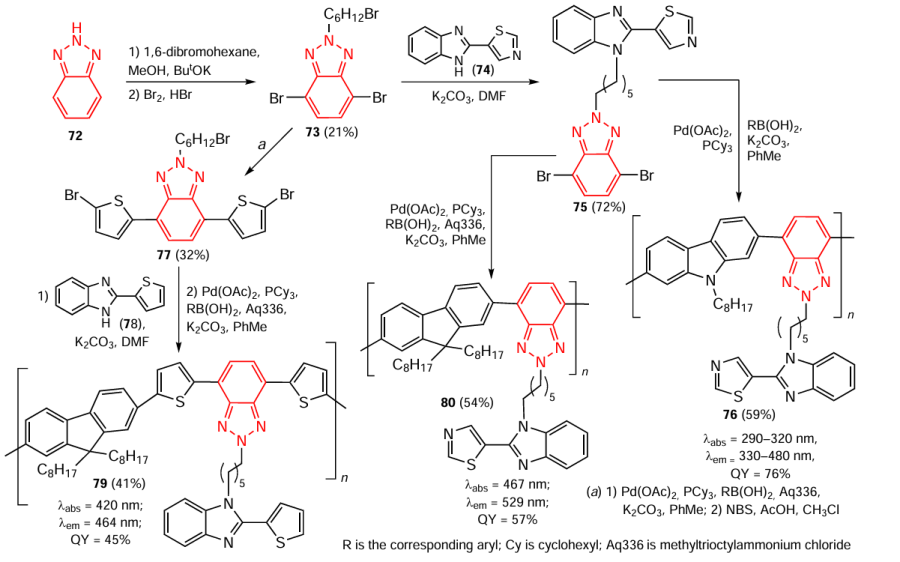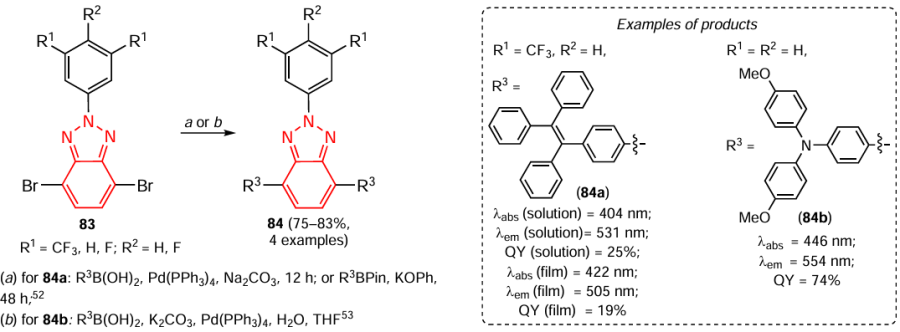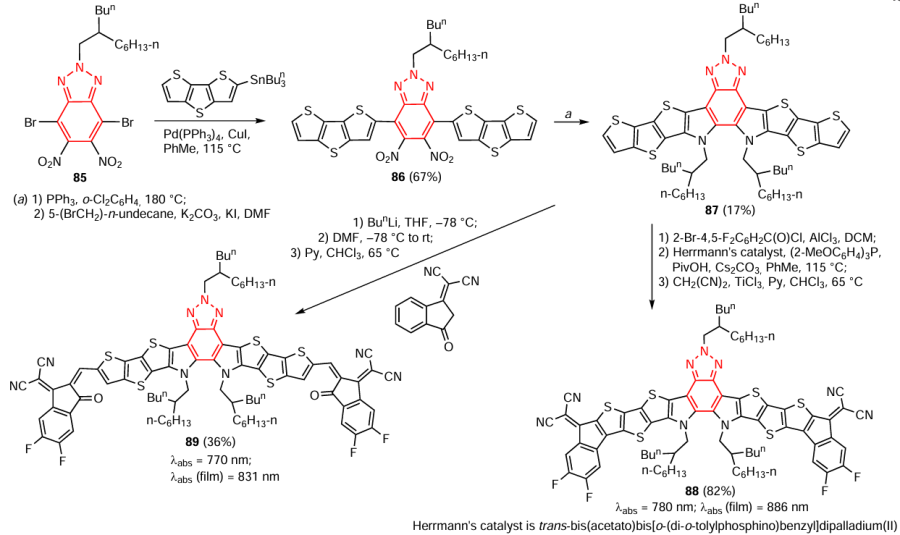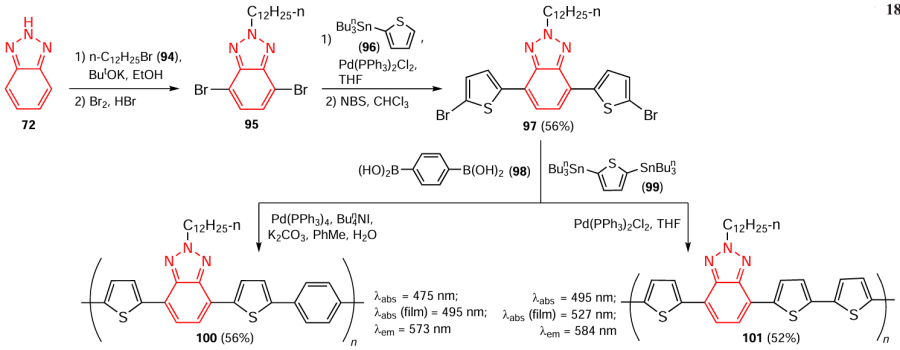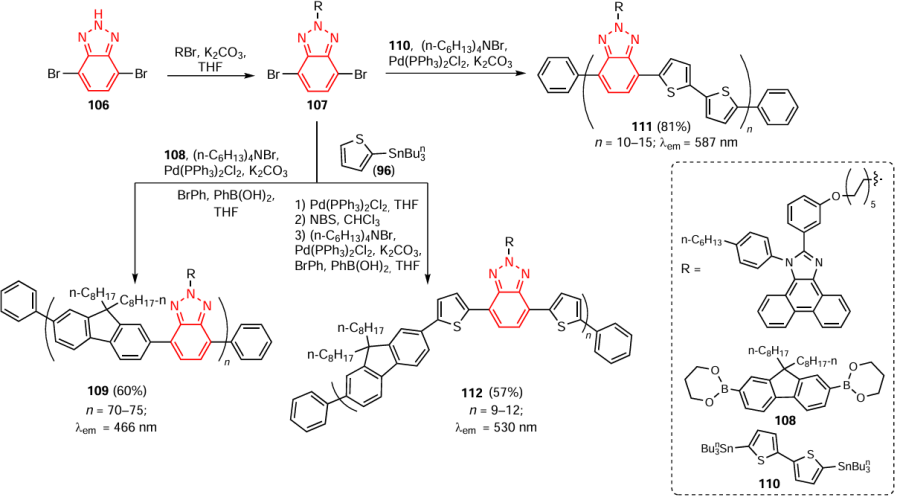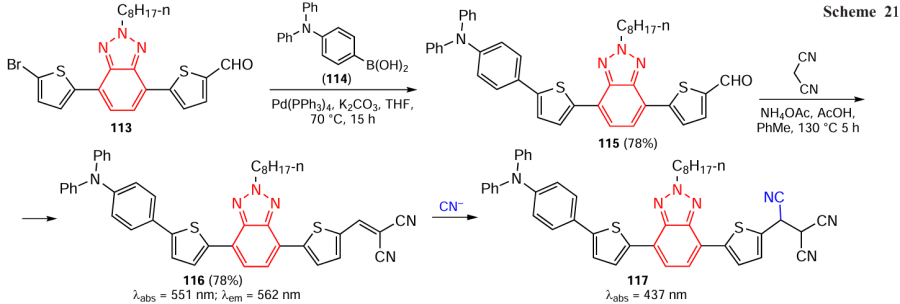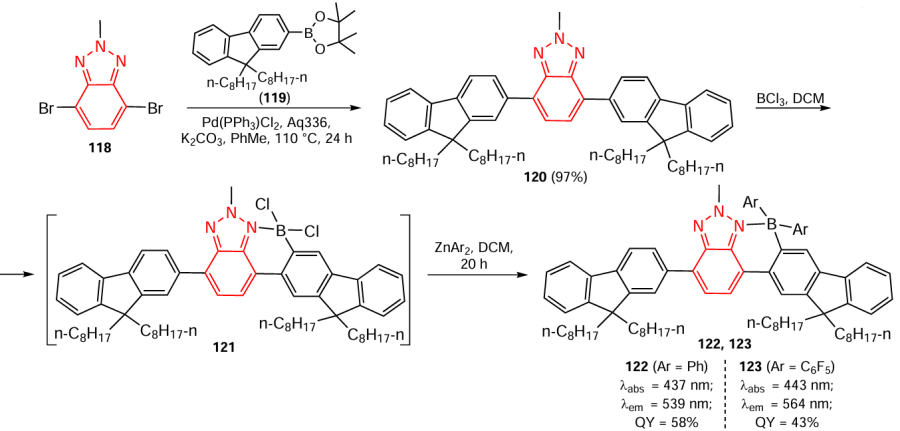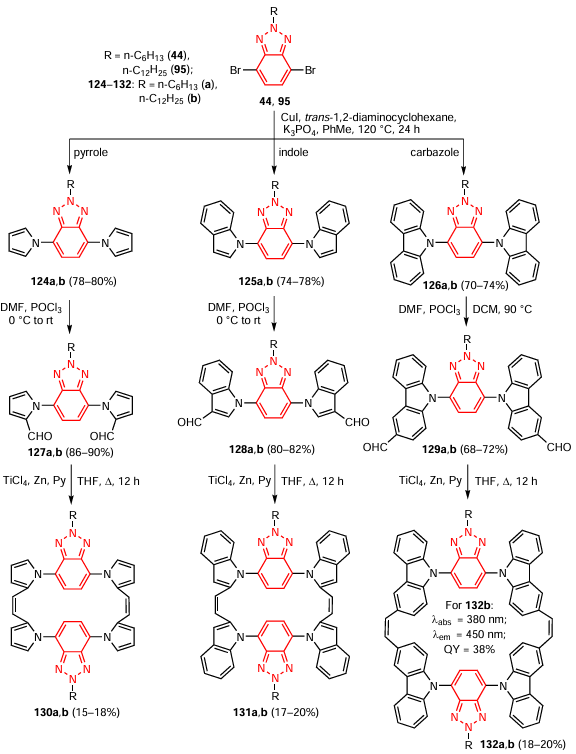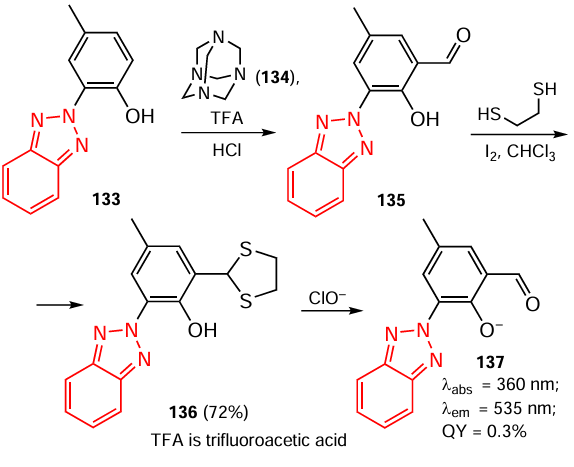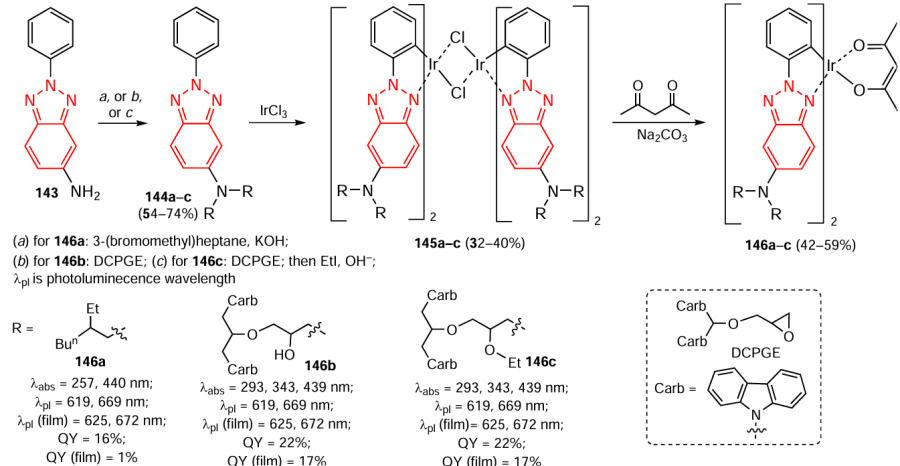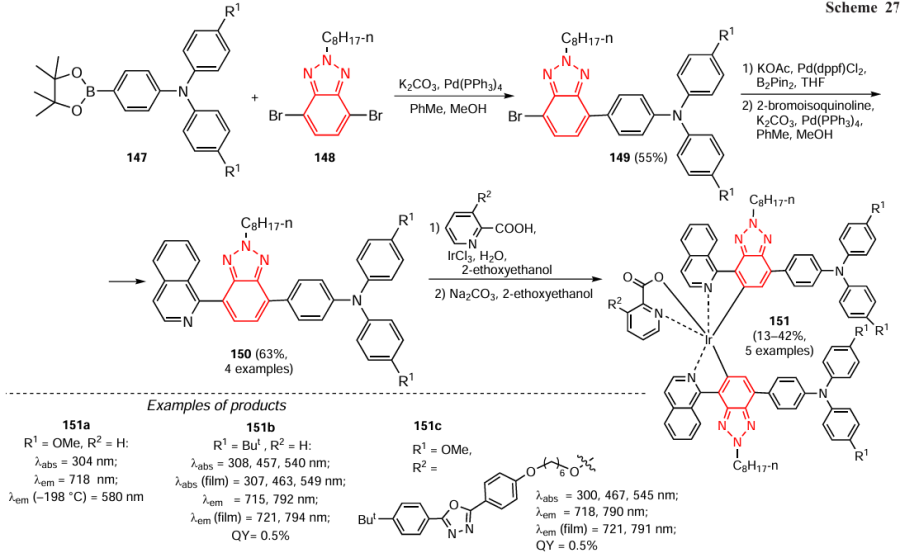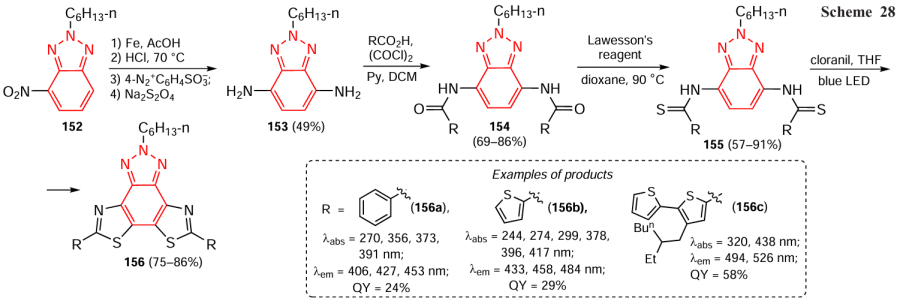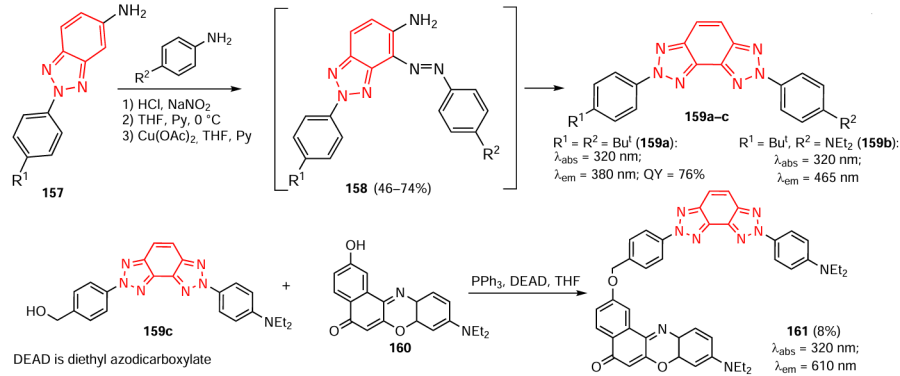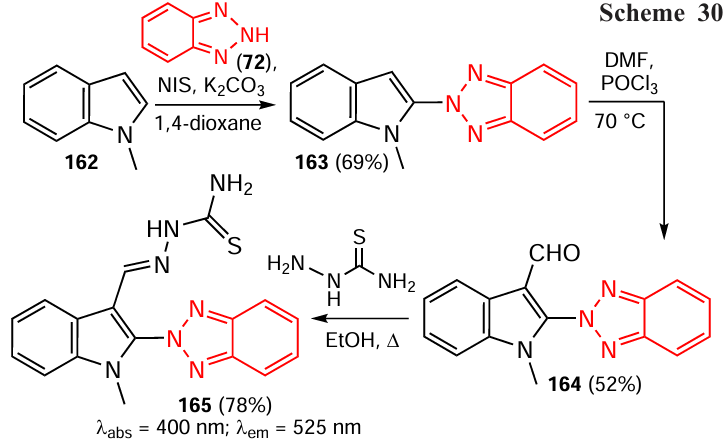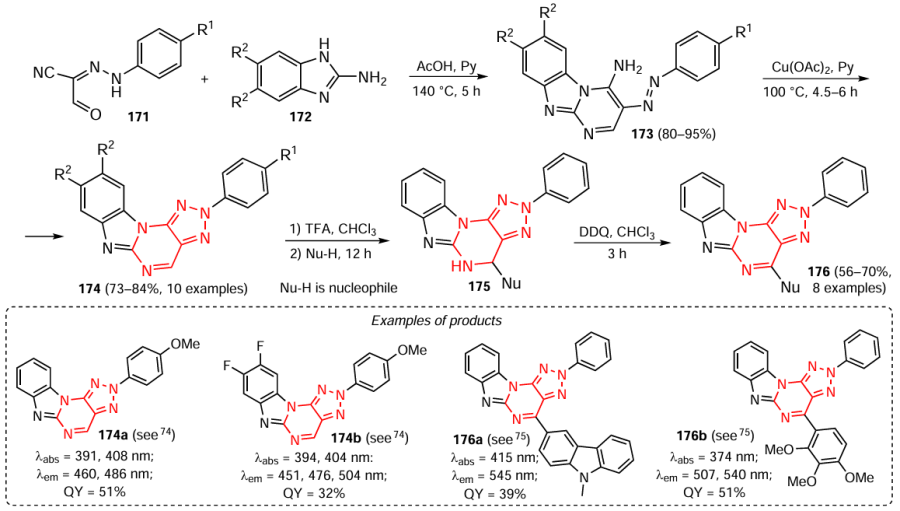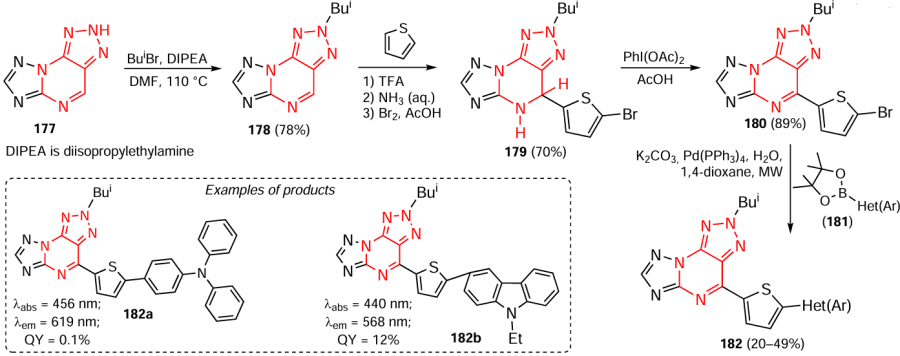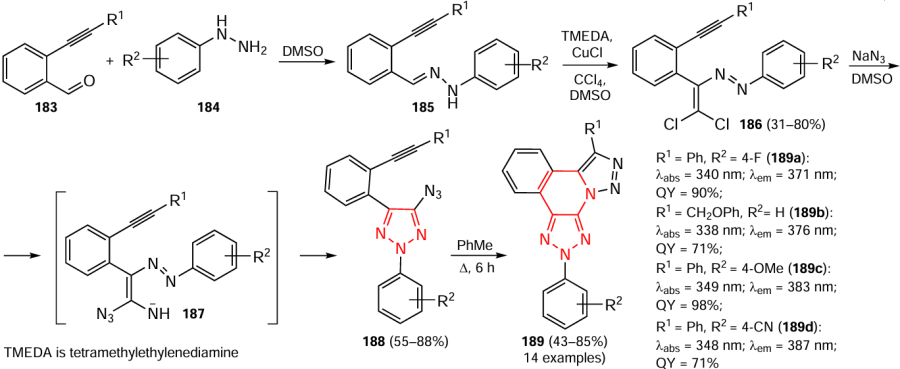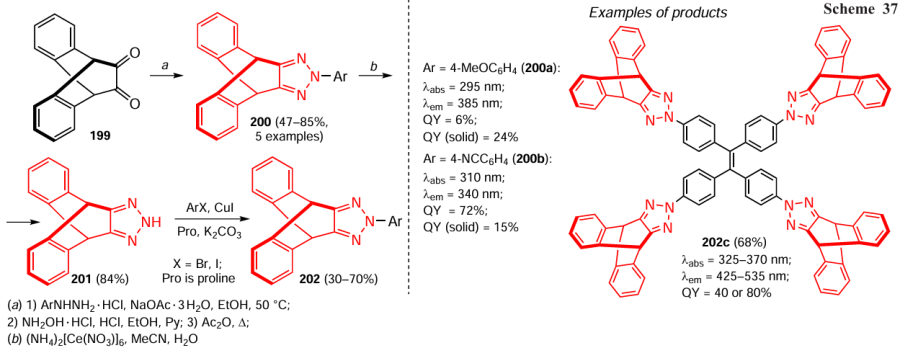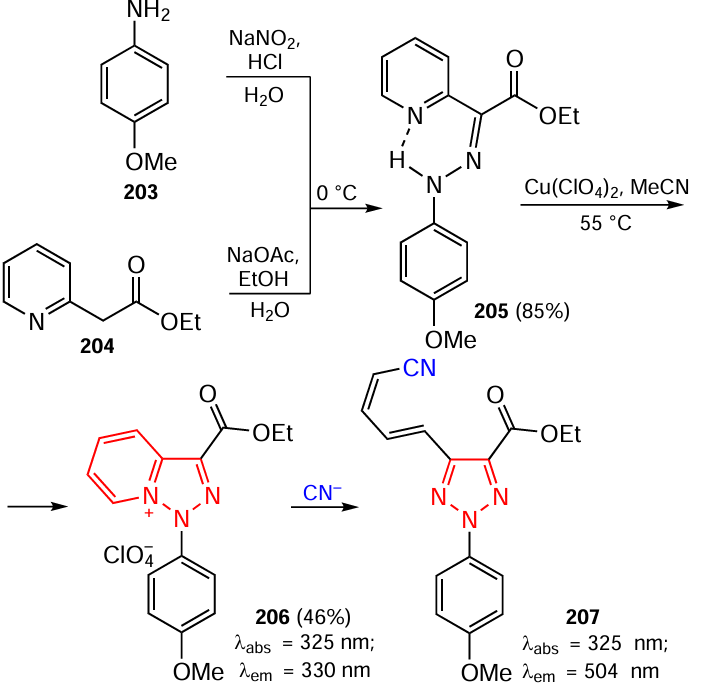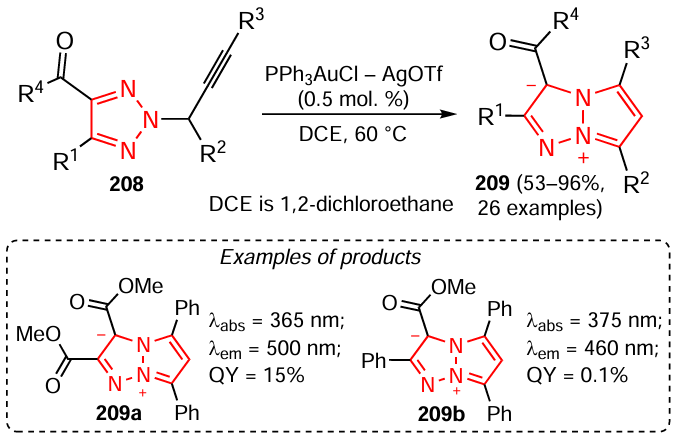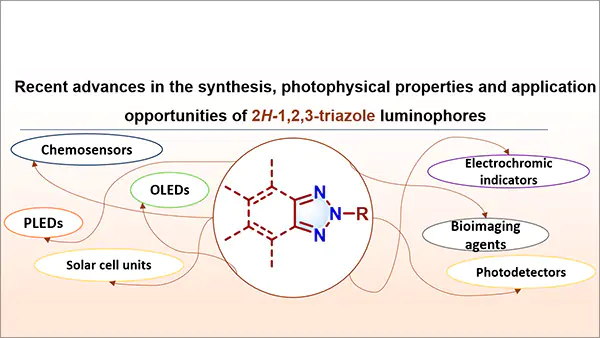Keywords
Abstract
The review systematizes the data on the synthesis of 2H-1,2,3-triazole-based luminophores published between 2005 and the beginning of 2024. The benefits and limitations of the described synthetic strategies are revealed. The possibilities and prospects for the practical applications of these molecular systems as chemosensors for pH and metal ion determination, bioimaging agents, and working elements of molecular electronic devices (organic light emitting diodes, organic field-effect transistors, etc.) are discussed. The bibliography includes 84 references.
1. Introduction
Today, the development of optical functional materials is a rapidly upcoming area of modern organic chemistry and related fields of science. Photoactive molecular systems are used as chemosensors, compounds for bioimaging and photodynamic therapy, organic light emitting diodes (OLEDs), organic field-effect transistors (OFETs), organic semiconductors, and other materials for molecular electronics.[1-5]
Compounds that possess promising photophysical properties can be obtained from either acenes (naphthalene, pyrene, etc.) or heterocyclic systems (azoles, azines, thiophenes, etc.). Heterocyclic compounds are of particular interest for the development of novel materials, since the introduction of heteroatoms affects the electronic structure of the molecule and crystal packing; this may give rise to valuable properties, and, hence, to expand the scope of practical applicability. In addition, in most cases, heterocyclic moieties increase the affinity of compounds to biological targets and also open wide possibilities for further modification.[6, 7]
1,2,3-Triazoles are photoactive compounds that give rise to two types of structures, namely, 1H- and 2H-functionalized 1,2,3-triazoles. 2H-1,2,3-Triazoles are used most often for the design of advanced materials, owing to their linear structure and conjugation, while 1H-triazoles are more popular as biologically active compounds.[8, 9]
The first mention [10] on the synthesis of 2H-1,2,3-triazoles dates back to 1921 (Fig. 1); however, their photophysical properties were described only 84 years later (see below). Since 2008, studies of luminescent chemosensors based on 2H-1,2,3-triazoles for detection of cations, anions, and nitroarenes have been rapidly developing. Further insight into this class of compounds resulted in the design of the first organic (OLEDs) and polymer (PLEDs) light-emitting diodes. By the end of the second decade of the 21st century and until now, 2H-1,2,3-triazoles have been widely used for bioimaging and photodynamic therapy, and as active elements of photodetectors.
Figure 2 shows examples of functional materials containing a 2H-functionalized 1,2,3-triazole moiety that are now actively studied as chemosensors for fluorescent pH determination,[11] reagents for metal ion detection,[12] OLED components,[13] medications for the treatment of various diseases,[14, 15] or diagnostic agents for bioimaging of cancer cells, fatty degeneration of cells, heart contraction, etc.
Diverse 2H-1,2,3-triazoles are synthesized using reactions of hydrazines with nitrogen-containing compounds, reactions of aromatic substrates with diazonium salts, arylation, cyclization of substituted alkynes with azides, and various types of cross-coupling. There are a few reviews [16-21] addressing the synthesis and biological properties of 2H-functionalized 1,2,3-triazoles, but they do not include data on the methods for the synthesis of these compounds for the use as functional optical materials. The present review summarizes the data published in the period from 2005 to the beginning of 2024 describing the known methods for the synthesis of luminophores based on 2H-1,2,3-triazoles, in particular 2H-aryl-substituted, benzo- and heteroannulated derivatives, their luminescent properties, and prospects for practical application.
2. Features of the electronic structure of 2H-1,2,3-triazoles
1,2,3-Triazole, a five-membered heterocycle composed of three nitrogen atoms and two carbon atoms, has a ring system of 6π-electrons and two multiple bonds in the molecule. Two triazole nitrogen atoms can be referred to the pyridine type and the third nitrogen can be classified as a pyrrole type. All 1,2,3-triazole atoms are sp2-hybridized, with π-electrons being in conjugation; therefore, the heterocycle is aromatic. There can be 2H-, 4H-, and 1H-1,2,3-triazoles, which are tautomers. 2H-1,2,3-Triazoles are used most widely for the design of functional optical materials (Fig. 3). Meanwhile, 1H-1,2,3-triazoles possess various types of biological activity and have found use as antifungal, antiviral, and other agents. Finally, 4H-1,2,3-triazole is not aromatic and has no stable forms.[22]
The pyridine type nitrogens are highlighted in red and pyrrole nitrogens are blue.
Among five-membered nitrogen-containing heterocycles, 1,2,3-triazole has one of the highest ionization energies, which vary in the following series: imidazole (8.78 eV), pyrazole (9.15 eV), 1,2,4-triazole (10.00 eV), 1,2,3-triazole (10.06 eV), and tetrazole (11.30 eV). In addition, 1,2,3-triazole has clear-cut acidic properties (pKa = 9.4), especially in comparison with 1,2,4-triazole, pyrazole, or imidazole, the pKa values of which are 10.3, 11.5, and 14.9.[23]
3. 2H-Aryl-1,2,3-triazoles
This Section addresses the key preparation methods and properties of 2H-substituted 1,2,3-triazoles containing different functional groups at carbon atoms in positions 4 and 5.
Benassi, Belskaya, and co-workers [24] developed a series of 5-amino-2-aryl-1,2,3-triazole derivatives. The target fluorophores 4 were prepared by the reaction of secondary amines 2 with arylhydrazononitriles 1 followed by cyclization of intermediates 3 in the presence of copper acetate Scheme 1; the maximum absorption (λabs) and emission (λem) wavelengths in the electronic spectra and the quantum yields (QY) are given below the structures].* These fluorophores show emission in the 410 to 446 nm range with Stokes shift ranging from 2494 to 9461 cm–1 and quantum yields of 4 to 99%. It is worth noting that electron-withdrawing substituents induce a red shift in the absorption and emission spectra.
In another study, the same authors [25] proposed a procedure for the preparation of a number of 2H-aryl-1,2,3-triazole-4-carboxylic acids. The starting triazoles 4 were obtained by a one-pot process, similar to that depicted in Scheme 1. The subsequent hydrolysis of the nitrile group was carried out under alkaline conditions using excess NaOH in a mixture of solvents (EtOH and H2O) with heating. In the presence of hydrochloric acid, amides 5 were converted to carboxylic acids 6 (Scheme 2). Fluorophores 6 showed a bright blue fluorescence in the range from 410 to 435 nm with quantum yields of up to 96%. It is noteworthy that the quantum yields varied depending on the pH, but the effect of compound structure on this characteristic could not be identified. Safronov et al.[26] described a number of sodium salts of carboxylic acids 6, which had similar properties, but were better soluble in organic solvents. Further modification of the products afforded a series of substituted amides 7 in moderate to high yields.[27] Some compounds exhibited the aggregation-induced emission (AIE) effect. In particular, in the case of compound 7a, the quantum yields varied depending on the DMSO to H2O ratio: for fw = 90%, the quantum yield can reach 99% ( fw is the fraction of water).
A popular method for the synthesis of 1,2,3-triazoles is the cycloaddition of azides to alkynes; for the selective formation of 2H-derivatives, disubstituted alkynes must be used in this reaction. A study on the design of blue-green fluorophores based on 1,2,3-triazole was performed by the research group headed by Hong and Lee.[28] As the starting compound, the authors used 4,4'-dibromotolane 8a or its dimethyl derivative 8b, which was subjected to 1,3-dipolar cycloaddition with sodium azide, resulting in the formation of intermediate triazoles 9a,b in moderate yields. The subsequent nucleophilic aromatic substitution (SNAr) involving 4-fluorobenzonitrile yielded 2H-functionalized 1,2,3-triazoles 10a,b. The final step was the Buchwald – Hartwig reaction with acridine derivatives, 9,9-dimethyl-9,10-dihydroacridine (A), 2,7-di-tert-butyl-9,9-dimethyl-9,10-dihydroacridine (B), or phenoxazine (C), giving rise to target products 11a – f (Scheme 3).
The products showed emission in the 464−524 nm range; the presence of a methyl group in the benzene ring induced a blue shift, while unsubstituted compounds (with R1 = H) showed red fluorescence. The authors also fabricated experimental OLEDs, which were characterized by electroluminescence in the blue to green spectral range (Fig. 4).
The research groups headed by Shi,[29-31] Tabolin,[32] Huszthy,[33] and Fu [34] developed similar methods for the synthesis of 2H-functionalized 1,2,3-triazole derivatives, consisting in the N-arylation of a triazole nitrogen atom (Scheme 4). In the first step, alkyne 12 reacted with sodium azide to give triazole 13. This product was either N-arylated according to the Chan – Lam coupling reaction (with boronic acids), or subjected to CuI-catalyzed C – Х/N – H coupling (Х = Br, I), or reacted with indole in the presence of N-iodosuccinimide. The yields of the resulting triazoles 14 varied from moderate to high.
Products 14 showed emission in the range from 329 to 550 nm, with the quantum yields being 30 to 99% for solutions and up to 46% for powders. In addition, depending on the nature of aromatic substituent, the Stokes shift changed from 522 to 14 219 cm–1. Compound 14d was found to exhibit chemosensory properties suitable for the recognition of enantiomeric 1-phenylethylamine (PEA) perchlorates, 1-(1-naphthyl)ethylamine, phenylglycine and phenylalanine methyl esters; some of these analytes are regulated precursors and, hence, they are subject to strict control. This chemosensor provides rapid detection of these compounds in the samples. As a rule, the emission intensity decreased two- to eight-fold in the presence of an analyte in the system; in the case of (S)-PEA, a threefold decrease in the emission intensity at 400 nm and appearance of new peaks at 600 nm were detected. Meanwhile, compound 14с containing an indole moiety in the molecule proved to form complexes with Pd, which can serve as the basis for effective catalysts of organic reactions.
Shi and co-workers [30] did not study the optical properties of the obtained triazoles, but used them as intermediates for condensation with о-phenylenediamine to give conjugates 15 with benzimidazole. These compounds exhibit chemosensory properties for the detection of silver ions; in the presence of the analyte, the emission intensity decreased 10-fold; the limit of detection (LOD) was 10–9 M.
The research group headed by Feng and He [35] proposed a synthesis of fluorescent 2H-phenyl-1,2,3-triazole derivative meant for the detection of Hg2+ ions (Scheme 5).
In the first step, the reaction of compound 16 with thionyl chloride yielded acid chloride 17, which then reacted with fluorescein derivative 18 to give product 19 in a moderate yield. This fluorophore has an emission maximum at 365 nm and selective response to Hg2+ ions; the addition of an analytical sample induced the appearance of an absorption peak at 563 nm and an emission peak at 577 nm. When mercury ions are present in the mixture, complex 20 is formed, and the solution becomes pink; this allows for naked-eye detection of the metal (Fig. 5).
A five-step method for the synthesis of push – pull fluorophores based on 2H-aryl-1,2,3-triazoles (Scheme 6) was developed by our group.[36, 37] First, hydrazine 21 was subjected to condensation with oxopropanal oxime to give hydrazone 22, which cyclized in the presence of copper sulfate to give triazole N-oxide 23 in a moderate yield. The subsequent bromination and the Suzuki – Miyaura reaction with boronic acids gave triazole N-oxides 24 and 25. It should be noted that in the presence of electron-donating substituents in the benzene ring, bromination occurs into the ortho-position relative to these groups, while in the presence of electron-withdrawing substituents, bromination is directed to the triazole ring. The N-oxide group was removed by reduction with zinc dust in a supersaturated solution of ammonium chloride, which gave fluorophores 26 and 27, for example compound 27а, in almost quantitative yields. This method is suitable for the synthesis of linear or Y-shaped fluorescent systems. These molecules have absorption peaks between 290 and 340 nm and emission peaks up to 470 nm and show quantum yields of up to 99%. Branched fluorophores 27 were found to exhibit chemosensory properties for the detection of nitroaromatic explosives [e.g., 2,4-dinitrotoluene (DNT)] with LOD of 278 ppm (Fig. 6).
Thus, in this Section, we considered methods for the synthesis of 2H-aryl-1,2,3-triazole derivatives containing different functional groups in the molecule at C(4) and C(5) atoms. Currently, there are several approaches to the preparation of this type of compounds such as azide–alkyne cycloaddition, arylation of 2H-1,2,3-triazoles, and cyclization of hydrazones. N-Arylation is most convenient from the synthetic standpoint; it can provide fine tuning of the physicochemical properties of functional materials prepared from such molecular blocks. Fluorophores of this type emit in the range below 500 nm with quantum yields of up to 99%; they are used as chemosensors and working elements of organic light-emitting diodes. It is noteworthy that the investigation for 2H-functionalized 1,2,3-triazoles exhibiting emission properties in the solid state is considered to be a promising line of research, as only one such example has been described so far.
* The numbering of compounds in this review corresponds to their positions in Schemes: from substrates to poducts.
4. Benzannulated 2H-1,2,3-triazoles
Below we consider the synthesis and luminescent properties of annulated 1,2,3-triazoles. The most common methods for the preparation of these compounds include cyclization of о-phenylenediamines followed by functionalization, (hetero)arylation of 2H-benzotriazoles, and Stille, Suzuki–Miyaura, and other cross-couplings
Ichikawa et al.[38] proposed a method for the synthesis of new fluorophores based on benzotriazole and 2,2´-bipyridine (Scheme 7). In the first step, o-phenylenediamine 28 was treated with aromatic nitro compounds in the presence of NaOH to give various diazo compounds 29, which were brominated and then subjected to oxidative cyclization induced by di(acetoxy)iodobenzene (PIDA) to form benzotriazoles 30. It is worth noting that this synthetic approach (diazotization and cyclization) is one of the most popular for the synthesis of 2H-functionalized 1,2,3-benzotriazoles. Substrates 30 were converted to boronic acids 31, which were allowed to react with 6-bromo-2,2'-bipyridine 32 to give the target compounds 33 in high yields. These luminophores are characterized by light absorption in the 375 to 390 nm range and emission in the 410 to 480 nm range. The synthesized fluorophores exhibited electroluminescence; they also had high thermal stability: their decomposition temperature (Tdec) was > 410 °C, i.e., it was higher than that for tris(8-quinolinolato)aluminium, which is widely used in light-blue OLEDs. In addition, this characteristic directly affects the decrease in the operating voltage of the devices. Thus, the obtained ensembles represent promising working components of organic light-emitting diodes (Fig. 7).
Bojinov et al.[39-41] and Uesaka et al.[42] reported the preparation of 1,8-naphthalimide benzotriazole derivatives (Scheme 8). First, benzotriazoles 34, 39 were allowed to react with 4-substituted 1,8-naphthalic anhydrides 35, 40 in acetic acid, which gave the corresponding 1,8-naphthalimide derivatives. Then the nitro group in compounds 36 and 41 was substituted for the piperidine (37 and 42) or prop-2-enylamine moiety in 45 – 72% yields. It is noteworthy that in the presence of amino group in the γ-position (conditions b), this group can be acylated to give compounds 38c, 43d–e (Table 1). These fluorophores absorb in the 330 – 440 nm range and emit in the 460 – 570 nm range, with the quantum yields being up to 66%. Compound 43a was found to possess chemosensory properties for determination of Cu2+ ions; the formation of the copper complex increased the emission intensity four-fold. Compounds 38b and 43b proved to be capable of detecting Zn2+ ions: the addition of the analyte resulted in an up to eight-fold increase in the emission intensity, depending on the concentration of the metal ions in solution. This behaviour may imply the possible use of these fluorophores as fluorescent detectors for metal ions. Thus, a versatile analytical platform for the design of selective fluorescent chemosensors for the determination of various divalent metal cations has been developed. Further studies in this area could be aimed at the design of devices with these compounds as working elements or at expansion of the range of analytes.
Chan’s research group [43] synthesized fluorophores based on triazoloquinoxalines. For this purpose, о-phenylenediamine 28 was first cyclized with sodium nitrite in acetic acid to give benzotriazole. The subsequent arylation and bromination gave product 44, the nitration of which led to dinitrobenzotriazole 45. This product was subjected to the Stille cross-coupling with stannane 46 and then the nitro group was reduced. The cyclization of the resulting diamine 47 with diketone 48 followed by one more bromination of the intermediate afforded the target compound 49, which was then co-polymerized with fluorene and pentiptycene derivatives (Scheme 9). Polymers 50 and 51 exhibit emission in the near-IR region (λ > 900 nm) with quantum yields of up to 14%. The authors revealed low toxicity of these fluorophores in 2 nM concentration against human ovarian cancer cells (SKOV-3). It was also shown that these products can be used to diagnose ovarian cancer in a laboratory mouse model. The quantum yields and fluorescence brightness of this polymer were 30 times as high as those for known [44] indocyanine green (ICG) and Alexa Fluor 790 dyes.
Wong and co-workers [45] developed a method for the synthesis of polymers containing a benzotriazole moiety (Scheme 10). The sequence of transformations included the Suzuki and Stille cross-coupling reactions involving aryl bromides 53 – 55 and 60 and also benzotriazole derivatives 52 and 59. This gave four polymers (56 – 58 and 61) with molecular weights from 3000 to 151 000 a.m.u in 73 – 98% yields. These fluorophores emit in the 486 – 708 nm range with quantum yields of up to 90%. Prototypes of PLED devices exhibiting electroluminescent properties (PVfill factor = 43, PCE = 0.4%) at V = 1.6 and 2.4 V were designed on the basis of polymers 57, 58, and 61 (Fig. 8). (PVfill factor is the fill factor for organic photovoltaics; PCE is the power conversion efficiency; V is the voltage). In addition, it was found that these compounds can be used in the acceptor layer in solar panel.
Pan et al.[46] proposed a method for the synthesis of polymeric benzotriazole-containing fluorophores (Scheme 11). The target compounds were obtained by six successive reactions. The benzotriazole ring was assembled by diazotization and cyclization of the starting compound 62; the subsequent alkylation and iodination resulted in 2-γ-vinylalkyl-1,2,3-benzotriazole 63. The next steps included silylation with reagent 64 in the presence of the Karstedt catalyst (65), cross-coupling with (2-thienyl)stannane, and bromination and produced the key triazole 67. This product was co-polymerized with heterocycle 68 in the presence of Pd(PPh3)4 to give polymers 69 with molecular masses from 4600 to 7900 a.m.u. Solutions of these polymeric fluorophores absorb in the 538 – 598 nm range, while the absorption of films occurs in the range from 400 to 800 nm. The authors measured the quantum efficiency of fluorescence,* which reached 66%. Quantum efficiency is a key characteristic for photosensitive devices. In addition, the open-circuit voltage (Voc) was 0.94. Thus, compounds with the indicated properties can be used in the design of energy-efficient solar panels.
Lu and co-workers [47] prepared polymers based on difluorobenzotriazole (Scheme 12). The method for the synthesis of these compounds included the palladium-catalyzed C – H/C – H couplings of 5,6-difluorobenzotriazole (70) with thiophene derivatives. Four polymers 71a–d with molecular weights of up to 41 000 a.m.u. were isolated in yields varying over a wide range. These compounds exhibited green and orange emission in the 540 – 620 nm range. OLED prototypes with quantum yields of 0.07 and 0.14% at a voltage of 3 to 4 V were designed on the basis of polymers 71a,b (Fig. 9). The maximum current efficiency for these devices was 0.25 cd A–1; the power efficiency ranged from 0.059 to 0.13 lm W–1.
The research group headed by Liu [48] proposed a method for the synthesis of polymers based on benzotriazole and benzimidazole conjugates (Scheme 13). A three-step process was used to form a polymer chain unit. Unsubstituted benzotriazole 72, used as the starting compound, was alkylated with 1,6-dibromohexane and brominated to give compound 73 in a relatively low yield; this product reacted with substituted benzimidazole 74 to give monomer 75. The Suzuki – Miyaura reaction was chosen for the polymerization, with the product yield being moderate. Polymer 76 had a molecular weight of 10089 a.m.u., and its electronic spectrum exhibited two absorption peaks in the ranges of 290 – 320 and 330 – 480 nm and one emission maximum in the 471 – 483 nm range, with the quantum yield being up to 76%. In addition, this compound exhibited chemosensory properties for the detection of I– anion [LOD of 10–4 M for 71b (P2)]; Fe3+, Cu2+, and Ag+ cations (LOD ≈ 10–5 M), and cysteine (Fig. 10). In another study of the same authors,[49] further modification of substrate 73 afforded two new polymers 80 and 79 with molecular masses of 32865 and 5096 a.m.u., respectively, in moderate yields. Both polymers absorbed in the 420 – 470 nm range, with their emission being in the 460 – 530 nm range; and the quantum yields were 45 – 57%. Like fluorophores described above, compounds 79 and 80 showed a similar chemosensory response for the detection of Fe3+ and Cu2+ cations [binding constant (K) ≈ 10–4 M–1], while iron(III) complex of compounds 79, 80 showed a response to PO4– ions (LOD ≈ 10–3 M) (Fig. 11, Fig. 12).
Tang and co-workers [50] and Wu and co-workers [51] described the synthesis of fluorophores with the D – π-A – π-D structure (D is donor, A is acceptor) including triazolobenzothiadiazole or its selenium analogue (Scheme 14). Tetraphenylethylene and triphenylamine moieties served as the electron-donating groups, while thiophenes acted as π-linkers. These photoactive compounds were prepared using a two-step method starting with the Stille cross-coupling reaction involving aryl bromides and (2-thienyl)stannane. This gave intermediate compounds, which were functionalized with an aza-heterocyclic moiety via an analogous reaction to give products 82a,b in up to 65% yields. Alternatively, the same compounds were obtained by the Miyaura borylation of triarylamine followed by Suzuki – Miyaura cross-coupling, which afforded the corresponding products in up to 87% yields. The products absorbed at 582 – 620 nm and emitted in the 750 – 930 nm range, which corresponds to the near-IR region. The quantum yields in solutions ranged from 17 to 49%. These compounds showed AIE effects at fw > 50%; in the case of compound 82а, a three-fold enhancement of the emission was observed. Furthermore, fluorophores 82а,b had low cytotoxicity (IC50 > 1000). Nanoparticles (NPs) of compound 82a were tested as agents for phototherapy of cancer cells in mice. Cell images were obtained by hematoxylin and eosin staining (H&E) and by detection of apoptotic DNA fragmentation (TUNEL method). These methods make it possible to evaluate the decrease in the number of cancer cells in the body after photodynamic therapy (Fig. 13). Compound 82b was used to monitor the heart rate (Fig. 14). A similar method is used to detect cardiac disorders and other pathological changes in the blood circulation system. In addition, these compounds proved to be effective for the detection of adipose bodies in a cell and, therefore, they can be used to diagnose hepatic steatosis.
Lu and co-workers [52] and Deng and co-workers [53] proposed similar methods for the synthesis of 4,7-disubstituted 2H-functionalized 1,2,3-benzotriazoles 84 in good yields by the Suzuki–Miyaura cross-coupling of substrates 83 with boronic acids or their pinacol esters (Scheme 15). These fluorophores emit at 455 – 590 nm [the molar absorption coefficient (ε) is > 22 000], with the quantum yields being up to 96%; they show positive solvatochromic effect and Stokes shift of up to 5530 cm–1. Films based on benzotriazole 84a were also prepared, and their photophysical properties proved to be similar to the properties of solutions. In addition, chemosensory properties for the detection of water in organic solvents were found; in the presence of water, the emission intensity decreased by a factor of eight. The limit of detection achieved using compound 84a was 0.009% for THF and 0.024% for 1,4-dioxane relative to the solvent volume (Fig. 15).
A research group headed by Liu and Miao [54] reported the synthesis of dipyrrolobenzotriazole-based fluorophores consisting of several (hetero)aromatic rings (Scheme 16). The first step was the Stille reaction of benzotriazole 85 to give intermediate 86, which was subjected to oxidative cyclization and alkylation to give compound 87. Product 88 was obtained in high yield by electrophilic substitution at position 2 of the thiophene ring, intramolecular cyclization in the presence of Herrmann’s catalyst, and condensation with malononitrile. Another derivative 89 was synthesized in a moderate yield by successive formylation and reaction with malononitrile. The obtained products absorb light in the near-IR region: below 780 nm in solution and below 886 nm in films. They have been used as photodetectors with dark current density (Jd) of 2.01 × 10−10 A cm−2 at a voltage of 0 V (Fig. 16).
Nguyen and co-workers [55] described a palladium-catalyzed three-component reaction of polymer synthesis from benzotriazole 90 involving thiophene 91 and phenoxazine 92 derivatives (Scheme 17). The molecular mass of polymer 93 was 11 300 a.m.u., and the polymer absorption peaked at 443 nm, while emission occurred in the red spectral range at 639 nm. This fluorophore showed chemosensory properties for the detection of trinitrotoluene (TNT) with a high selectivity and LOD = 10–6 M. In addition, this chemosensor is characterized by a response in both the solid state and gaseous phase, which allows it to be used for the analysis of explosives in air and in soil. Using this compound, test strips for fast detection of TNT in various media were manufactured (Fig. 17).
Toppare and co-workers [56] reported the synthesis of ambipolar polymers based on benzotriazole 72 (Scheme 18). In the first step, the starting benzotriazole is alkylated with dodecyl bromide (94) and brominated with molecular bromine to give compound 95; this is followed by the Stille reaction with thiophene derivative 96. Intermediate 97 is again brominated with NBS, and then the Suzuki – Miyaura cross-coupling with boronic acid 98 or the Stille reaction with distannylthiophene 99 is carried out to furnish polymers 100 or 101 in moderate yields. The molecular weights of polymers 100 and 101 are 7000 and 10 000 a.m.u., respectively. These compounds exhibit emission in the range from 573 to 584 nm in solutions and in thin films. Their photophysical and electrochemical characteristics indicate that both polymers are applicable as the working elements of electrochromic indicators (Fig. 18).
Valiyaveettil’s research group [57] proposed a method for the synthesis of fluorescent polymers, conjugates of benzotriazole and BF2-dipyrromethene (BODIPY) (Scheme 19). The alkynyl BODIPY derivative 102 reacted with either 4,7-dibromo-2-dodecylbenzotriazole 95 or triazoloquinoxaline 103 to give products 104 or 105 in high yields. The molecular weights of polymers 104 and 105 range from 16 000 to 89 000 a.m.u., and emission occurs in the range of 650 – 750 nm in solutions and 740 – 920 nm in films, with the quantum yields reaching 15%. These compounds exhibit chemosensory properties suitable for the detection of benzene, toluene, and other volatile organic solvents.
Toppare and Cirpan’s research group [58] prepared three different polymers based on benzotriazole and phenanthroimidazole conjugate (Scheme 20). Initially, benzotriazole 106 reacted with imidazole to give intermediate 107, which then underwent the Suzuki – Miyaura cross-coupling with diboronic ester 108 or Stille cross-coupling (with reagents 110 or 96), giving rise to polymers 109, 111, and 112, respectively, in up to 81% yields. The polymers emit light at 466, 530, and 587 nm in solutions, while in the spectra of their films, the bands are red-shifted by 15 to 67 nm. Polymers 109, 111, and 112 were found to exhibit electroluminescence, fast switching to the oxidized coloured form under the action of electrical current (switching time τ of 0.2 s), and contrast (T, meaning the ratio of the black to white level) of up to 64%, depending on the structure (Fig. 19). The authors proposed to use these polymers as working elements of organic light-emitting diodes.
Quan and co-workers [59] developed a benzotriazole-containing fluorescent chemosensor for the determination of cyanide anions (Scheme 21). The synthesis consisted of two successive steps; the first one was the Suzuki – Miyaura reaction of benzotriazole 113 with boronic acid 114, while the subsequent Knoevenagel reaction of aldehyde 115 with malononitrile afforded the target compounds 116 in a high yields. This chemosensor showed high selectivity and sensitivity to CN– ions present in a mixture with other cations and anions (Fig. 20). After the addition of an analytical sample, the cyanide adds to the double bond of compound 116, and the absorption maximum of adduct 117 is blue-shifted from 551 to 437 nm, with its intensity increasing 17-fold. The limit of detection for this chemosensor is 10–8 M, which is much lower than the minimum concentration in drinking water (1.9 mM) according to World Health Organization safety standards. In addition, it was found that this compound is applicable to detection of cyanide anions in pheochromocytoma cells (PC-12) (Fig. 21).
Turner and Ingleson’s research group [60] proposed a method for the synthesis of new fluorophores based on benzotriazole boracycles (Scheme 22). First, benzotriazole 118 underwent the Suzuki–Miyaura reaction with arylboronic acid pinacol ester 119 to give intermediate 120, which subsequently reacted with BCl3 , which resulted in C – H activation of the neighbouring aromatic ring and formation of fused unstable boracycle 121. The final step was the reaction with diarylzinc to give two new fluorophores 122 and 123 in 91 and 86% yields. The resulting fluorophores have an absorption band in the range from 437 to 443 nm and an emission band in the range from 539 to 564 nm, with quantum yields being up to 58%.
Rajakumar and co-workers [61] synthesized new benzotriazole-based cyclophanes containing a pyrrole, indole, or carbazole moiety (Scheme 23). In the first stage, benzotriazoles 44 and 95 underwent N-H-arylation with azaheterocycles in the presence of CuI to give intermediate compounds 124 – 126. The subsequent reactions with POCl3 furnished aldehydes 127 – 129, which dimerized in the presence of TiCl4 to give macrocycles 130 – 132 in relatively low yields. Among the obtained compounds, only cyclophane 132b has luminescent properties with emission maximum at 450 nm and quantum yield of 38%. In addition, this fluorophore exhibits chemosensory properties and can be used for the detection of picric acid (LOD = 10–6 ppm).
The research group headed by Chattopadhyay [62] developed a synthetic protocol towards benzotriazole-based fluorophores (Scheme 24). In the first step, the formylation of benzotriazole 133 in the presence of hexamethylenetetramine (134) gave derivative 135, which then reacted with ethanedithiol to give the target product 136 in a moderate yield. The obtained fluorophore possesses an absorption maximum at 360 nm and an emission maximum at 535 nm, and exhibits chemosensory properties for the determination of hypochlorite ions (LOD = 10–10 М) in the pH range from 4 to 11. Upon the reaction with compound 136, the 1,3-dithiolane moiety was converted to the carbonyl group giving rise to anion 137, for which the luminescence quantum yield increased from 0.3 to 5%. In addition, benzotriazole 136 has low cytotoxicity; therefore, it can be used to detect hypochlorite in living cells, for example, during the development of breast cancer (Fig. 22). The authors also fabricated paper strips for the determination of hypochlorite ions in various media (Fig. 23).
Michaelis and Hernandez – Fernandez’s research group [63] proposed a method for the synthesis of ethyl (Z)-benzotriazolylacrylates (Scheme 25). First, the authors alkylated benzotriazole 72 with ethyl bromoacetate in the presence of K2CO3 , which afforded isomers 139 and 140 in various yields. Although 1H-substituted triazole 140 was formed as the major product, the authors prepared a luminescent system based on 2H-triazole. In the presence of piperidine under the action of microwave radiation (MW) or heating, benzotriazole 139 underwent the Knoevenagel reaction with p-amino-substituted aromatic aldehydes 141 to give products 142a – d. In the reaction induced by heating, compound 142с formed in the lowest yield (20%), which could be markedly increased by conducting MW-assisted reaction at 100 °C for 80 min. For all obtained fluorophores, the absorption peaks in the electronic spectra were located in the range from 340 to 416 nm, while the emission peaks were in the 460 – 520 nm range. Compound 142а was found to possess low cytotoxicity against HEK293T cells (IC50 = 50 μM) and to be applicable as a fluorescent probe for bioimaging (Fig. 24).
A few papers are devoted to luminescent iridium complexes in which a 2H-functionalized 1,2,3-benzotriazole moiety is present as a ligand. Getautis’s research group [64] proposed a synthesis of these complexes from 2-phenyl-1,2,3-benzotriazoles containing carbazole moieties (Scheme 26). The desired ligand was obtained by alkylating the amino group in the starting benzotriazole 143; and the target iridium(III) complex was obtained from products 144 via two steps. The first step was the synthesis of dimeric coordination compound L4Ir2Cl2 (145), which was then treated with acetylacetone being thus converted to the metal complexes L2Ir(acac) (acac is acetylacetonate) (146a – c). The resulting compounds are readily soluble (in organic solvents); they show red phosphorescence with an emission maximum at 650 nm, lifetime of 5.7 ms, and quantum yields of 22 and 17% for solutions and solid samples (films and powders), respectively. Experimental red OLEDs with up to 22 V voltage at the maximum brightness and quantum efficiency of up to 1.8% were developed on the basis of these compounds (Fig. 25).
A method for the synthesis of iridium complexes based on isoquinolin-4-ylbenzotriazole with picolinic acid and its derivatives (Scheme 27) has been proposed.[65-67] The synthesis of the target ligand included the Suzuki – Miyaura reaction involving triarylamine type boronic acid 147 and dibromobenzotriazole 148, the subsequent borylation of bromide 149, and one more Suzuki – Miyaura reaction with 2-bromoisoquinoline to form product 150. The complex is synthesized by a two-step procedure similar to that described in the above example; altogether five compounds 151 were isolated in moderate yields. The products showed emission in the electronic spectra up to 792 nm in solutions and up to 794 nm in films, with the fluorescence quantum yields for the films being 0.5%. OLED devices with quantum efficiency of 1.15% were fabricated on the basis of metal complexes 151 (Fig. 26). However, this quantum efficiency proved to be markedly lower than these values for known OLEDs (10 – 30%).[68] It should be noted that at –198 °C, the emission band of compound 151a was blue-shifted to 580 nm. The fluorescence properties of thin films did not differ from those of solutions. Experimental red-emitting PLED devices with quantum efficiency of up to 0.4% were developed on the basis of these metal complexes (Fig. 27 and Fig. 28; OXD-7 is 1,3-bis[2-(4-tert-butylphenyl)-1,3,4-oxadiazol-5-yl]benzene, TPBI is 1,3,5-tris(1-phenyl-1H-benzimidazol-2-yl)benzene, ITO is indium tin oxide, PEDOT:PSS is poly(3,4- ethylenedioxythiophene)-poly(styrene sulfonate), PVK is poly(9-vinylcarbazole)).
Fisyuk’s research group [69] reported fluorophores based on bis(thiazolo)benzotriazole (Scheme 28). The target photoactive molecules were obtained from 2-hexyl-4-nitrobenzotriazole 152 by a six-step procedure. One amino group was formed upon the reduction of the nitro group with iron filings in acetic acid, while the other one resulted from the azo coupling reaction followed by reduction with sodium dithionite. The subsequent acylation of compound 153, thionation of diamides 154 with Lawesson’s reagent [2,4-bis(4-methoxyphenyl)-1,3,2,2,4-dithiadiphosphophetane 2,4-disulfide], and intramolecular cyclization of thioamides 155 furnished products 156a – с. These luminophores exhibit two to five absorption peaks in the electronic spectra between 244 and 448 nm, emission in the 406 – 526 nm range, and quantum yields of up to 58%. In addition, electropolymerization of these compounds resulted in the formation of polymers exhibiting red to blue-green electroluminescence, characterized by high thermal stability, and applicable as electrochromic devices (Fig. 29).
Lee and co-workers [70] reported the synthesis and photophysical characteristics of 2H-functionalized bis(triazolo)benzenes (Scheme 29). These fluorophores were prepared in 46 to 74% yields by azo-coupling of benzotriazole 157 with para-substituted anilines followed by cyclization of intermediates 158 to form heterocycles 159. The products emit in the blue and green regions of the visible spectrum with wavelengths ranging from 380 to 465 nm. Compound 159b show response to the change in the pH of the medium: increase in the concentration of protons in solution induces a blue shift of the emission peaks from 465 to 385 nm. The reaction of derivative 159с with phenoxazine 160 gives conjugate 161 with emission peak at > 600 nm wavelength.
Lv et al.[71] developed a method for the synthesis of fluorophore based on 2-indolylbenzotriazole (Scheme 30). First, benzotriazole 72 was arylated with 1-methylindole (162) in the presence of N-iodosuccinimide; the subsequent Vilsmeier – Haack reaction of compound 163 resulted in the formation of aldehyde 164, which reacted with thiosemicarbazide to give the target product 165. The obtained luminophore has an absorption peak at 400 nm and emission in the range from 425 to 700 nm. This compound was found to exhibit chemosensory properties suitable for the detection of cations: for example, in the presence of Ag+, the fluorescence intensity increases eight-fold. Conversely, in the presence of Hg2+ and Cu2+ ions, the fluorescence intensity decreases four-fold. A considerable drawback of the obtained chemosensors is that the simultaneous detection of any pair of the above ions is impossible.
A few research groups used a similar synthetic approach to prepare fluorophores based on 2-substituted naphtho[1,2-d]- [1,2,3]triazoles. In the first step, arene 166, containing an amino group, reacted with sodium nitrite and hydrochloric acid to give diazonium salt 167; this product underwent azo coupling reaction with naphthalimines 168 to yield compounds 169, which cyclized to the target products 170 (Scheme 31). In particular, Sekar’s research group [72] proposed a method for the synthesis of benzimidazole and benzotriazole conjugates. The resulting fluorophores possess blue and green emission and are characterized by quantum yields of 20 to 57%. The same authors obtained conjugates with imidazole in 79 to 87% yields. These fluorophores absorb in the 335 – 373 nm range and emit in the blue region (370 to 470 nm); the quantum yields are 14 to 19%. Under the supervision of Oliveira – Campos,[73] fluorescent compounds containing a naphthalene-fused triazole moiety (20 to 49% yield) were obtained. These fluorophores show emission in the 360 – 380 nm range, with the quantum yields being 83%.
Thus, this Section presents methods for the synthesis of 2H-1,2,3-benzotriazole derivatives that exhibit chemosensory properties and are used as agents for bioimaging, phototherapy and as components of light-emitting and electrochromic devices. The main approach to compounds of this class is cyclization of diazonium salts followed by functionalization, which involves either the nitrogen atom in position 2, being performed by (hetero)arylation, or the annulated ring, being usually performed by Suzuki – Miyaura or Stille cross-coupling reaction. The presence of several annulated rings enables modification of these molecules, which can be used for the targeted design of photoactive compounds with valuable properties. A promising but not yet fully elaborated lines of research are the synthesis of polymers meant for bioimaging of various intracellular processes or detection of pathologies at early stages and the synthesis of ligands for second- and third-generation organic light-emitting diodes based on transition metal complexes.
* The ratio of the number of photons the absorption of which causes the formation of quasi-particles to the total number of absorbed photons.
5. Heteroannulated and miscellaneous derivatives of 2H-aryl-1,2,3-triazoles
This Section addresses the synthesis of 2H-1,2,3-triazole-based fluorophores containing a heterocyclic annulated moiety and derivatives that have not been described above. The key approaches to the preparation of these structures are intramolecular cyclization reactions.
The research group of Fedotov and Belskaya [74] proposed an approach to the synthesis of new polycyclic 8-azapurines (Scheme 32) with a triazole ring. This approach includes the condensation of aminobenzoimidazoles 171 with 3-oxo-2-phenylazopropionitrile 172 and the subsequent oxidative cyclization of compounds 173 in the presence of copper(II) acetate to give products 174a – e in moderate to high yields. The resulting fluorophores absorb in the 379 – 399 nm range, emit in the 471 – 505 nm range, and have lifetimes of up to 4.7 ns and quantum yields of up to 60%. Charushin and co-workers [75] showed that it is possible to perform further modification of compounds by nucleophilic substitution of hydrogen (SNH). The substitution at the H – C=N bond in the pyrimidine ring on treatment with various nucleophiles (thiophene, phenol, indole) affords stable σ-adducts 175, which are then oxidized with 2,3-dichloro-5,6-dicyano-1,4-benzoquinone (DDQ). Functionalized compounds 176a,b emit in the range from 507 to 570 nm, with the quantum yields being up to 60%. In addition, the obtained luminophores were found to exhibit acidochromism and AIE effect. In the former case, the emission intensity considerably decreases when protons are present in the system, while the formation of aggregates induces a blue shift of the emission (Fig. 30 and Fig. 31).
Verbitsky et al.[76] synthesized triazoles with an annulated triazolopyridine ring containing electron-donating groups in the molecules (Scheme 33). The first step is the reaction of 177 with isobutyl bromide, which affords 2H-substituted compound 178. The subsequent nucleophilic substitution under the action of thiophene, bromination, oxidation of intermediate 179, and the Suzuki – Miyaura reaction involving bromide 180 and arylboronic acid picolinate 181 lead to target products 182 in 20 – 49% yields. The fluorophores prepared in this way emit in the 562 – 619 nm range with quantum yields of up to 12%. The authors found chemosensory properties for detection of nitroaromatic compounds such as DNT (2,4-dinitrotoluene), 2,4-dinitroanisole, picric acid, trinitroresorcinol, 1,3,5-triethoxy-2,4,6-trinitrobenzene, 2,4,6-trinitrotoluene, and nitrobenzene. The limits of detection vary in the range from 10–1 to 10–5 mol L–1, depending on the analyte (Fig. 32).
Nenajdenko’s research group [77] described a three-step synthesis of a 1,2,3-triazole-based heterocyclic system (Scheme 34). First, N-substituted hydrazones 185 were obtained by condensation of carbonylacetylenes 183 with arylhydrazines 184. The subsequent alkyl halogenation (intermediate 186), azidation (187), and intramolecular cyclization of azide 188 afforded the target bitriazoles 189 in 43 – 85% yield. Heterocyclic compounds of this series have two triazole rings in the molecule. These fluorophores absorb in the 312 – 348 nm range and emit in the blue region from 370 to 390 nm; the quantum yields are up to 98%.
Belskaya, Benassi, and co-workers [78] developed a two-step method for the synthesis of triazolopyrimidines (Scheme 35). Pyrimidines 192 were prepared by the reaction of compounds 190 with isothiocyanates 191 in the presence of 1,8-diazabicyclo[5.4.0]undec-7-ene (DBU) on heating. The subsequent cyclization in the presence of copper acetate gave compounds 193a – l in up to 85% yields. Note that the reaction was accompanied by hydrolysis of the thiocarbonyl group to carbonyl group. The resulting fluorophores 193 showed emission in the blue spectral region (from 400 to 443 nm) and a Stokes shift of up to 26015 cm–1; the quantum yields reached 39%. According to the next study,[79] these compounds exhibit acidochromism and chemosensory properties for the detection of HCl vapour. In addition, they were found to stain all cell organelles except the nucleus and, hence, they can be considered as fluorescent dyes for bioimaging (Fig. 33).
The research group headed by Yu and Lu [80] reported a synthesis of triazolopyridines (Scheme 36). The key intermediate 195 was prepared by cyclization of compound 194 induced by sodium nitrite in acetic acid. This intermediate then reacted with various alkyl halides in the presence of potassium carbonate to form 2H-functionalized triazolopyridines 196, which were subjected to the Stille reaction with stannane 197 to give products 198 in moderate to high yields. Fluorophores 198 have quantum yields of 80 to 89% in solutions and 26% in powders. Their chemosensory properties for pH determination from 4 to 7 were found: in particular, in acidic solutions, a blue shift of emission is observed in the electronic spectra, while in alkaline solutions, a red shift takes place. The authors manufactured paper strips for pH measurement that can be used to analyze the quality of water or the content of hydrogen chloride in air (Fig. 34).
Lee and co-workers [81] obtained fluorophores combining the 1,2,3-triazole moieties and an iptycene cage in the molecule (Scheme 37). The iptycene type dicarbonyl starting compound 199 was allowed to react, first, with arylhydrazine and then with hydroxylamine and acetic anhydride to give triazoles 200. To study the effect of various substituents at the N(2) atom, the authors dearylated triazole 201 by the oxidation with cerium(IV) ammonium nitrate (CAN) in high yield and conducted the copper(I)-catalyzed reaction with aryl halides. Products 202 showed absorption up to 280 nm in the spectrum; the emission intensity peaked in the range from 340 to 495 nm, while the quantum yields reached 72% in solution and 24% in the solid state. Kim et al.[82] synthesized tetrasubstituted iptycene triazole derivative 202c, containing a tetraphenylethylene moiety that absorbed photons in the 325 – 370 nm range and exhibited mechanoluminescence in the 425 – 535 nm range. The quantum yields were above 40% in the usual state and 80% after the mechanical treatment (Fig. 35).
The research group headed by Aprahamian [83] proposed a method for the synthesis of a chemosensor based on pyridine-fused 1,2,3-triazole (Scheme 38). The first step was the preparation of the diazonium salt from para-methoxyaniline 203, the azo coupling of which with pyridine derivative 204 gave intermediate 205. The subsequent oxidative cyclization resulted in triazole 206 in a moderate yield. This compound absorbs at 365 nm and emits at 400 nm. In the presence of cyanide anions, the emission intensity of product 206 sharply increases, and an additional peak at 504 nm appears in the emission spectrum due to ring opening and formation of 2-functionalized 1,2,3-triazole 207.
The research group of Shi and Li [84] synthesized fluorophores based on triazapentalene zwitter-ions (Scheme 39). The synthesis was based on gold-catalyzed intramolecular condensation of triazoles 208 containing a triple bond in the side chain. The target products 209 were formed in moderate to almost quantitative yields. These fluorophores show emission in the 450 – 500 nm range; the quantum yields of materials with two ester groups reach 15%, while in the case of one ester group, they do not exceed 1%.
Thus, this Section addresses methods for the synthesis and luminescent properties of heteroanullated and miscellaneous 2H-1,2,3-triazole derivatives. The synthesized compounds can be used as chemosensors for pH determination, detection of nitroaromatic compounds and acids, as well as dyes for bioimaging applications. A relatively small number of methods for the synthesis of compounds of this class have been reported in the literature; therefore, their practically useful properties have not been adequately studied and, hence, further studies are needed to find new applications for these derivatives.
6. Conclusion
This literature review describes and systematizes methods for the synthesis of 2H-functionalized 1,2,3-triazoles and their (hetero)annulated analogues, as well as photophysical characteristics of these compounds and discusses their possible practical applications. The photoactive molecules of this class find applications as chemosensors, organic light-emitting diodes, compounds for bioimaging, and agents for photodynamic therapy.
Among the title compounds, benzannulated 1,2,3-triazoles have been studied most comprehensively. Most often, they are synthesized using a combined approach consisting of the assembly of the benzannulated ring and further functionalization via cross-coupling reactions of various types. Quite a few functional polymers have been obtained on the basis of these compounds and prototypes of molecular electronic devices have been designed. It is worth noting that the use of only these derivatives as ligands for second-generation phosphorescent organic light-emitting diodes is known to date.
Meanwhile, 2H-functionalized 1,2,3-triazoles and their heteroannulated analogues have not been comprehensively studied. The emission of these triazoles extends up to the red spectral region and the quantum yields are high; however, there are only a few examples of their application as working elements of various devices. Non-fused 1,2,3-triazoles are prepared using two major methods: azide–alkyne cycloaddition followed by functionalization via cross-coupling reactions of various types and assembly of the heterocyclic nucleus via cyclization. The heteroannulated derivatives are prepared, most often, by oxidative cyclization of the corresponding molecular ensembles.
Thus, 2H-functionalized 1,2,3-triazoles represent a promising platform for the design of optical functional materials. Certain advances in this field have been made in recent years and active research is in progress. In the future, one can expect that these compounds would underlie the design of new organic semiconductors, rectifiers, and other components of the existing and future organic electronics, as well as dyes for bioimaging, probes, and chemosensors for the environmental monitoring and for detection of various analytes in bio-objects (cell organelles and biological fluids).
This review was prepared with the financial support of the Russian Science Foundation (Project No. 20-73-10077, https://www.rscf.ru/en/project/20-73-10077/).
7. List of abbreviations and symbols
The following abbreviations and symbols were used in the review:
ε — molar absorption coefficient;
λabs — absorption wavelength;
λem — emission wavelength;
λex — excitation wavelength;
λpl — photoluminescence wavelength;
τ — switching time to another form;
F — fluorescence intensity;
fw — fraction of water in the mixture;
J — current density;
Jd — dark current density;
Tdec — decomposition temperature;
T — contrast ratio;
V — voltage;
Voc — open circuit voltage;
A — electron-withdrawing moiety;
acac — acetylacetonate;
AcH — 9,9-dimethyl-9,10-dihydroacridine;
AIE — aggregation-induced emission;
All — allyl;
Aq336 — methyltrioctylammonium chloride;
BODIPY — BF2 dipyrromethene;
B2Pin2 — bis(pinacolato)diboron;
CAN — cerium(IV) ammonium nitrate;
CBP — 4,4'-bis(N-carbazolyl)-1,1'-biphenyl;
Cy — cyclohexyl;
D — electron-donating moiety;
DBU — 1,8-diazabicyclo[5.4.0]undec-7-ene;
DCE — dichloroethane;
DCM — dichloromethane;
DDQ — 2,3-dichloro-5,6-dicyano-1,4-benzoquinone,
DEAD — diethyl azodicarboxylate;
DIPA — diisopropylamine;
DIPEA — diisopropylethylamine;
DMA — dimethylacetamide;
DNT — 2,4-dinitrotoluene;
dppf — 1,1'-bis(diphenylphosphino)ferrocene;
EQE — external quantum efficiency;
HBTU — benzotriazol-2-yltetramethyluronium hexafluorophosphate;
H&E — eosin;
Herrmann’s catalyst — trans-di(acetate)bis[о-(di-о-tolylphosphino)benzyl]dipalladium(II);
ICG — indocyanine green;
Lawesson’s reagent — 2,4-bis(4-methoxyphenyl)-1,3,2,4-dithiadiphosphetane 2,4-disulfide;
LDA — lithium diisopropylamide;
LOD — limit of detection;
MW — microwave radiation;
NBS — N-bromosuccinimide;
NIR-II — near-IR range;
NIS — N-iodosuccinimide;
NPs — nanoparticles;
NuH — nucleophile;
OFET — organic field-effect transistor,
OLED — organic light-emitting diode;
OPD — organic photodetectors;
PBS — phosphate-buffered saline;
PCC — pyridinium chlorochromate;
PCE — power conversion efficiency;
PEA — phenylethylamine;
POH — phenoxazine;
PIDA — phenyliodine(III) diacetate, di(acetoxy)iodobenzene;
Piv — pivaloyl;
PLED — polymer light-emitting diodes;
PVfill factor — fill factor for organic photovoltaics;
Pro — proline;
PTC — phase transfer catalyst;
Py — pyridine;
QY — quantum yield;
rt — room temperature;
tAcH — 2,7-di-tert-butyl-9,9-dimethyl-9,10-dihydroacridine;
TBS — tert-butyldimethylsilyl;
TEA — triethylamine;
TFA — trifluoroacetic acid;
TMEDA — tetramethylethylenediamine;
TMS — trimethylsilyl;
TNT — trinitrotoluene;
TPAP — tris(4-methoxyphenyl)phosphine;
Tris — tris(hydroxymethyl)aminomethane;
TUNEL — terminal deoxynucleotidyl transferase dUTP nick end labelling.
References


















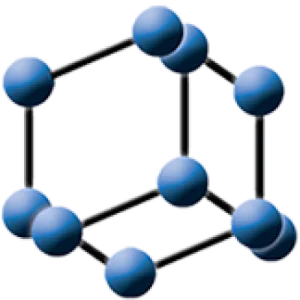
















![Bipyridyl-substituted benzo[1,2,3]triazoles as a thermally stable electron transporting material for organic light-emitting devices](/storage/images/resized/leiAYcRDGTSl5B1eCnwpSGqmDEUEfDPPoYisFGhT_small_thumb.webp)

![Novel functionalized 2-(2-hydroxyphenyl)-benzotriazole – benzo[de]isoquinoline-1,3-dione fluorescent UV absorbers](/storage/images/resized/GDnYOu1UpMMfMMRV6Aqle4H0YLLsraeD9IP9qScG_small_thumb.webp)




























![Synthesis, Photophysical, and (Spectro)Electrochemical Properties of New Benzo[1,2-c][1,2,5]thiadiazoles and Benzo[1,2-d][1,2,3]triazoles Fused with Two Thiazole Rings](/storage/images/resized/iLiQsFqFaSEx6chlGQ5fbAwF6VYU3WWa08hkss0g_small_thumb.webp)





![Abnormal push-pull benzo[4,5]imidazo[1,2-a][1,2,3]triazolo[4,5-e]pyrimidine fluorophores in planarized intramolecular charge transfer (PLICT) state: Synthesis, photophysical studies and theoretical calculations](/storage/images/resized/GDnYOu1UpMMfMMRV6Aqle4H0YLLsraeD9IP9qScG_small_thumb.webp)
![New 2 H -[1,2,3]triazolo[4,5- e ][1,2,4]triazolo[1,5- a ]pyrimidine derivatives as luminescent fluorophores for detection of nitroaromatic explosives](/storage/images/resized/GDnYOu1UpMMfMMRV6Aqle4H0YLLsraeD9IP9qScG_small_thumb.webp)


![2-Aryl-2,4-dihydro-5H-[1,2,3]triazolo[4,5-d]pyrimidin-5-ones as a New Platform for the Design and Synthesis of Biosensors and Chemosensors](/storage/images/resized/bRyGpdm98BkAUYiK1YFNpl5Z7hPu6Gd87gbIeuG3_small_thumb.webp)








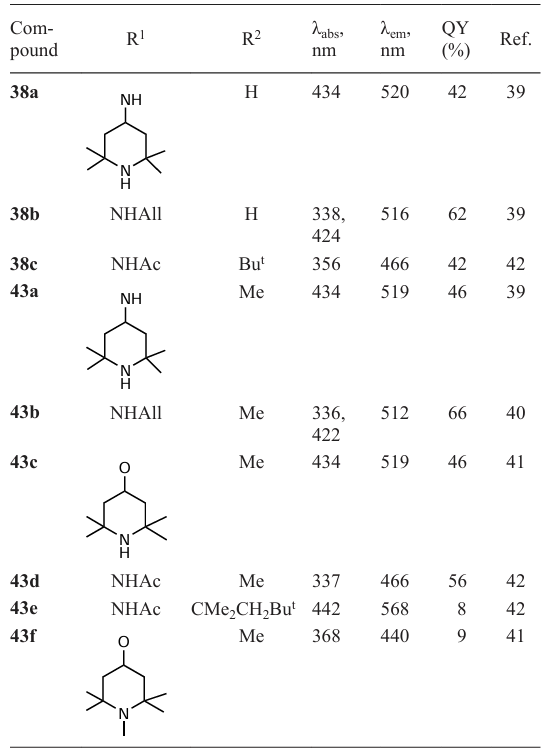



![Diagram of the device and comparison of LUMO and HOMO energies of the components (a) and chemical formulas of some of the used compounds (b); electroluminescence spectra (c) and external quantum efficiency (EQE) vs. luminance (d ); current density and luminance vs. voltage (e). Reproduced from Lee and co-workers [28] with permission from the American Chemical Society. (ITO is indium tin oxide, LUMO is the lowest unoccupied molecular orbital, HOMO is the highest occupied molecular orbital).](/storage/images/resized/sO9EnmC4pOBzwJTTfb38vbeHNISRPsGHpxI67eTm_xl.webp)
![Fluorescence spectra (a) and fluorescence intensity (F) (b) of compound 19 in a DMF — water (1 : 1 v/v) mixture and tris(hydromethyl) aminomethane hydrochloride (Tris-HCl) at pH 7.4 in the presence of various cations (40 μM concentration; excitation wave length λex = 563 nm); the upper part shows photographs of solutions of compound 19 in the presence of Hg2+ and other metal ions. Reproduced from He and co-workers [35] with permission from Elsevier.](/storage/images/resized/ZhX2HmZBpuZwZwuSKW01suRhMzEg0blgi6jyzSKB_xl.webp)
![Photometric titration involving DNT (a), two-dimensional fluorescence attenuation profiles (b), and results of time correlated single photon counting (TCSPC) determination of fluorescence quenching of compound 27a upon the addition of DNT recorded at λem = 369 nm (c). Reproduced from Lavrinchenko et al.[37] with permission from Springer Nature.](/storage/images/resized/lsYp5o69fFrqIB8l6CsqeRCgAIMU4PulMM3P5AiZ_xl.webp)
![Current density vs. voltage (a) and luminous efficiency vs. current density (b) for compounds 33a – d. The inset shows the electroluminescence spectra of compound 33b: experimental curve (solid line) and 10-fold magnification (dashed line). The curve Ref. shows analogous dependences for the device without the test fluorophores; the HTM curve refers to hole-transporting materials. Reproduced from Icihikwa et al.[38] with permission from the Royal Society of Chemistry.](/storage/images/resized/DEk5Qj5wRLodfgmphO3OOMYdU6Y0fya7IwZfNBNd_xl.webp)
![Current density vs. voltage for PLED devices with polymers 56 – 58, respectively (а) and electroluminescence spectra of PLEDs based on compounds 56 and 57 (b). Reproduced from Wong and co-workers [45] with permission from the Royal Society of Chemistry.](/storage/images/resized/ahwSPWo3EMGjl4mf43HIq6jo0LUEgrIw7BbsXQTu_xl.webp)
![Luminance vs. voltage (a) and current efficiency (b), power efficiency (c), and external quantum efficiency (d) vs. luminance of PLEDs based on compound 71a,b; and photographs of devices based on polymer 71a with green emission (e) and polymer 71b with red emission at a voltage of 8 V. Reproduced from Lu and co-workers [47] with permission from MDPI.](/storage/images/resized/TdGjik38P2EwlbimDUJUTF9vXx319hUcyZIS9JR1_xl.webp)
![Photographs showing the emission of polymer 79 in the presence of metal cations under daylight (above) and under UV light (below). Reproduced from Liu and co-workers [48] with permission from Springer Link.](/storage/images/resized/KxjRFnv7VvOPUhw4qESQltHcOovrmzzGkZk1afJM_xl.webp)
![Photographs showing the emission of complex [79-Fe3+] with anions under daylight (above) and under UV light (below). Reproduced from Liu and coworkers [48] with permission from Wiley.](/storage/images/resized/Haxa2XqCL6MxTjIqhPEg9Ru1ziYfvrPLQwTD4niN_xl.webp)
![Photographs showing the emission of complex [80-Fe3+] with anions under daylight (above) and UV light (below). Reproduced from Liu and co-workers [49] with permission from Wiley.](/storage/images/resized/bnW5o9Y39bLEJiHvr0Y3kVLQXBASdO8BLx03WDtD_xl.webp)
![Images of mice bearing 4Т1 tumours under laser radiation at 660 nm for different time intervals after the injection of 82a nanoparticles (a), temperature change in the 4Т1 tumour-bearing mice after the intravenous injection of 82a NPs and phosphate-buffered saline (PBS) under laser irradiation (λ = 660 nm, power of 0.5W cm–2) for 10 min (b), change in the relative tumour volume after different types of treatment (c), images of four groups of 4T1 tumour-bearing mice after 14 days of treatment (d ); confocal laser microscopy images of H&E- and TUNEL stained tumour tissues after different types of treatment (e). Reproduced from Tang and co-workers [50] with permission from the American Chemical Society.](/storage/images/resized/5WmeHG8Zrwj1sj5YLsrMa5l0C7O3D0r8ZLRUIzbG_xl.webp)
![Fluorescence imaging of mouse in vivo (а); NIR-II imaging (NIR-II is the near IR region) with intravenously injected 82b nanoparticles and heartbeat and respiratory curves recorded by monitoring oscillations of the fluorescence signal from the heart (ROI-1 is the region of interest 1) and liver (ROI-2 is the region of interest 2) (b); and variation of NIR-II images with time after subcutaneous injection of the agent through the pad of the foot (λex = 730 nm, 1100LP optical filter, τ = 10 ms irradiation time) (c). Reproduced from Wu and co-workers [51] with permission from Wiley](/storage/images/resized/KwmKm5tPN63Z7DR9ECFEodZnh7nltCC7hwb7HplC_xl.webp)
![Emission spectra of compounds 84а (a) and 84b (b) in various solvents; photographs of solutions of 84а (с) and 84b (d) at room temperature (above) and under irradiation with UV lamp (λex = 254 nm) (below). Reproduced from Deng and co-workers [53] with permission from Elsevier](/storage/images/resized/honF7tJDC1oOpU3C1bvuKJDDwnwjBgOocj82fpj2_xl.webp)
![Responsivity of organic photodetectors (OPD) with the active layer based on the thiophene-containing polymer PBDB-T and compounds 88 and 89 before and after 18 h irradiation at 100 mW cm–2 simulating solar light (а) and before and after storage under inert atmosphere (N2) for 600 h (b); block diagram of operation of OPD devices (c) and pulse signal measured with a laser at λ = 808 nm through a fingertip (the inset shows the OPD image) (d). Reproduced from Wang and co-workers [54] with per mission from Wiley.](/storage/images/resized/X46bi4eU6TKjuVO2138HNKTdePCV82FXyPf6hEpR_xl.webp)
![Photographs of paper test strips coated with compound 93 after adding TNT solution in different concentrations (a) and selectivity of TNT detection in the presence of other analytes (b). Reproduced from Nguyen and co-workers [55] with permission from Elsevier.](/storage/images/resized/BVNlG1cGwJxJ4qd4OiLQVLN0VOnNRTS4g1yEZkHS_xl.webp)
![Colours of polymers 100 (above) and 101 (below) in neutral oxidized state. Reproduced from Toppare and co-workers [56] with permission from the Royal Society of Chemistry.](/storage/images/resized/rT1NHNRA5CwsDljooYFw73O0IPqI6KMQ2g4P0dF5_xl.webp)
![Current density (J) and luminance vs. voltage (V) for organic light-emitting diode based on polymers 109 (а), 111 (b), and 112 (c). Reproduced from Cirpan and co-workers [58] with permission from Elsevier](/storage/images/resized/DvHzBIn0tiHHsLgWvSTbyEFeJGqBcUte7GAtl20n_xl.webp)
![Absorption (a) and emission (b) spectra of compound 116 (in 10 μM concentration) after the addition of CN− and other anions; diagram of the change in the fluorescence intensity of compound 116 in THF in the presence of only CN− (1), CN− with Cl− (2), CO32− (3), ClO4− (4), HSO4− (5), Br− (6), AcO− (7), HPO42− (8), H2PO4− (9), NO3− (10), I− (11), or F− (12) anions, and in the absence of any anions (13) (c); photographs of solutions of compound 116 with anions under daylight (d) and under irradiation with light at λex = 430 nm (e). Reproduced from Quan and co-workers [59] with permission from Elsevier.](/storage/images/resized/Tij2Fs41KPb80Ms0i6grnD2LdXmx4heclIpJXp3R_xl.webp)
![Confocal fluorescence microscopy images of PC12 cells: bright-field (a) and dark-field (b) images of cells incubated with compound 116 and merged image (c); bright-field (d) and dark-field (e) images of cells incubated with compound 116 and CN– and merged image (f). λex = 488 nm; 500 – 550 nm detection range. Reproduced from Quan and co-workers [59] with permission from Elsevier.](/storage/images/resized/6OheBXy72wZMPbPqwuvHlntgm9TnFDRBfdHerQzN_xl.webp)
![Confocal fluorescence microscopy images of MCF-7 (A) and J774A1 (B) cells: (I) control group; (II) cells incubated with compound 136; (III) cells treated with ClO– anions; (IV) cells treated with ClO– anions and then with compound 136; phase-contrast images (а) and fluorescence images (λex = 480 nm, λem = 520 nm) (b), and merged image (c) are given. A DMi8 fluorescence microscope with a Plan Fluor objective (40X, NA 0.60), Leica Microsystems GmbH. Reproduced from Chattopadhyay and co-workers [62] with permission from the Royal Society of Chemistry.](/storage/images/resized/NrrhiFytJATE54UYSquFeWBrquvOcldX76wgX3Vo_xl.webp)
![Photographs of the paper strips treated with compound 136 directly (a) and with addition of ClO– in concentration of 50 (b), 100 (c), 200 (d), or 300 mM (е). Reproduced from Chattopadhyay and co-workers [62] with permission from the Royal Society of Chemistry.](/storage/images/resized/QgN61HBC0oWLzysrs7JBMe4796iVAanaqEJxOGtG_xl.webp)
![Confocal fluorescence microscopy images of HEK293T cells incubated with compound 142a and DCB (dextran–cascade blue) for 16 h (a) and for 20 h followed by incubation with compound 142a alone in 10 μM concentration for 4 h (b). Reproduced from Michaelis and co-workers [63] with permission from the Royal Society of Chemistry.](/storage/images/resized/aQxporataqDcinQYhUo9JhoYBhIF7Qy3J86dbzB2_xl.webp)
![Chromaticity diagram of iridium complexes 146. The vertices of the triangle indicate coordinates of the RGB primary colours specified by the HDTV standard. Reproduced from Getautis and co-workers [64] with permission from Elsevier.](/storage/images/resized/iwbmmK1c87srwvWoDXFvzQwthDArEEYvMcZzVDEK_xl.webp)
![Energy level diagram (on the left) and structure of PLED device based on compound 151a. Reproduced from Chattopadhyay and co-workers [62] with permission from Elsevier.](/storage/images/resized/2MmPhjD7zkS7EZf3zDgQe0dHeJcGBhKJnLu6lRyr_xl.webp)
![Energy level diagram (on the left) and structure of organic light-emitting diodes based on compounds 151b, 151d (R1 = R2 = H) and 151e (R1 = F, R2 = H). Reproduced from Yu et al.[67] with permission from Elsevier](/storage/images/resized/FLsbrr0yijRKjweXgNmzFWnoHWXgPoeYN1vjkjqW_xl.webp)
![Atomic force microscopy images of 4,4'-bis(Ncarbazolyl)-1,1'-biphenyl (CBP) films doped with compounds 151b,d,e (a – c, respectively). Ra is the surface roughness. Reproduced from Yu et al.[67] with permission from Elsevier](/storage/images/resized/w7ux5kimCJI7xkGycLyWA2K98mAQ9sHVTz5pP1a0_xl.webp)
![Absorption spectra of thin films of polymers 156b (above) and 156с (below) measured in the p-doping mode and photographs of films with voltage-dependent emission. Reproduced from Fisyuk and co-workers [69] with permission from the American Chemical Society.](/storage/images/resized/kPfRMKy3rPt6AyYWBCWgc9o73IhSX2AX6CdGes9K_xl.webp)
![Emission spectra of compounds 176b in a МеOH – water solution with different component contents (vol.%) (a) and I/I0 ratio (I0 is the fluorescence intensity in pure MeOH) vs. the fraction of water (vol.%) (b); the inset shows photographs of the emission for solutions of compound 176b (10–5 M) in methanol (0) and in water with 10% MeOH under UV irradiation (λex = 365 nm). Reproduced from Charushin and co-workers [75] with permission from Elsevier](/storage/images/resized/V0cJQEDLPRPBXgKoZVnR9Liawm8CGYDyRUgYKoRQ_xl.webp)
![Absorption (a) and emission (b) spectra of compound 176а upon the addition of TFA. The inserts show the photographs of solutions of compound 176а alone (on the left) and in the presence of TFA (on the right). Reproduced from Charushin and co-workers [75] with permission from Elsevier.](/storage/images/resized/kv9hlOoSDE9ijSneT9O1IzrdeASwhwNAATInp9qQ_xl.webp)
![Photographs of the fluorescence of compounds 182 in MeCN (1 – 3) and in MeCN containing DNT (4 – 6) under daylight (a) and after light irradiation at λex = 376 nm (b). Reproduced from Verbitsky et al.[76] with permission from the Royal Society of Chemistry.](/storage/images/resized/wb8kfHq34kn8QoeZs1bfT0TjmAZPs8TkC9B2IBTs_xl.webp)
![Confocal fluorescence microscopy images of HeLa cells incubated with compound 193a in PBS at 37 °C for 0.5 h: light field image (a); at λex = 405 nm with a 405 – 430 nm filter (b); at λex = 488 nm with a 488 – 600 nm filter (c); overlay of images (d). Reproduced from Belskaya and co-workers [79] with permission from Wiley.](/storage/images/resized/tGFkFGqcDYaxjyQEeOp0ReRuSeUUSrWkChQ4uFhJ_xl.webp)
![Fluorescent paper strips for the detection of acids in the presence of compounds 198a (a) and 198b (b). Reproduced from Lu and co-workers [80] with permission from the Royal Society of Chemistry.](/storage/images/resized/d6CNZAgGOitgOd3FkJrg3SNuAJQVZgStaEb0x0Tc_xl.webp)
![Normalized absorption spectra (black curve with black circles) in CHCl3 (C = 10 mM), excitation spectra for the powders (blue curve with light circles), and fluorescence spectra (green curve with filled circles) for compound 202с in the usual state (а) and after mechanical treatment (b). λex = 370 nm. Reproduced from Kim et al.[82] with permission from the Royal Society of Chemistry.](/storage/images/resized/87mlQqf4HCAIcnt96LiQqNQyO6pIWyd5YOkeBtFU_xl.webp)
